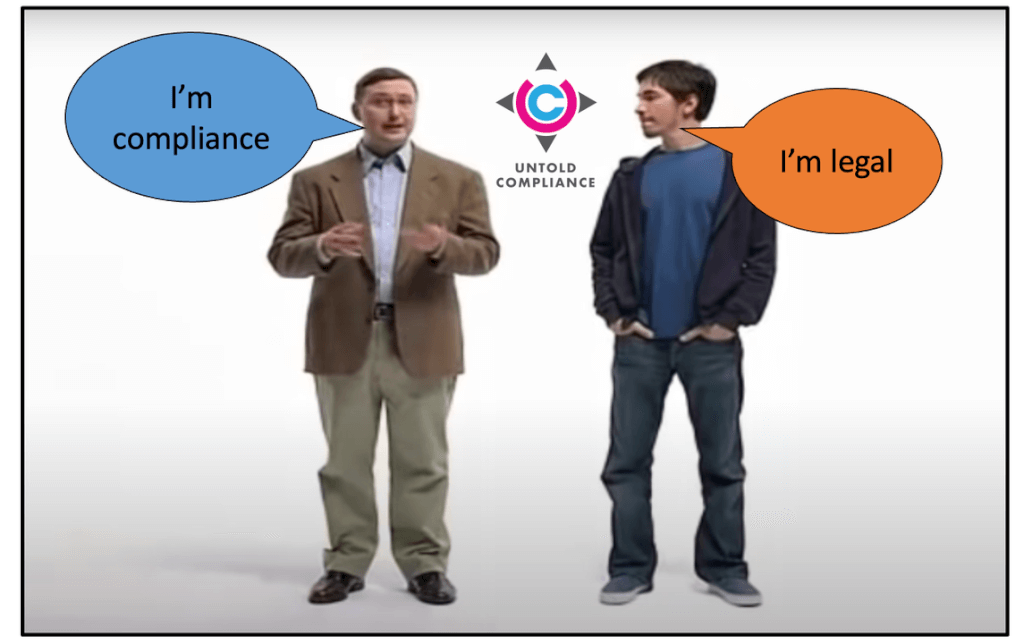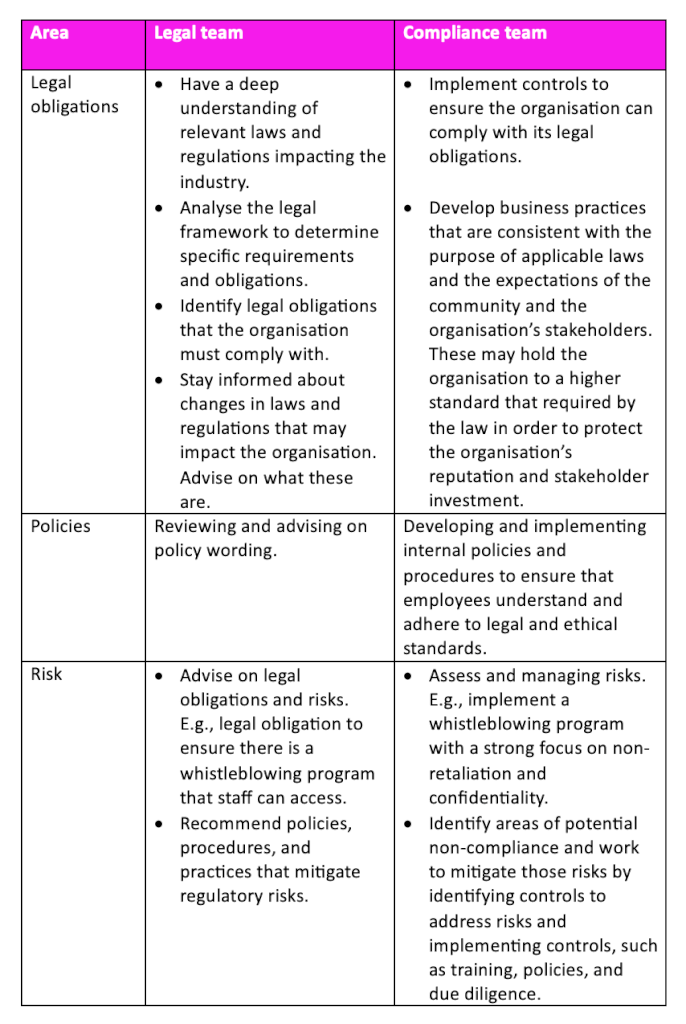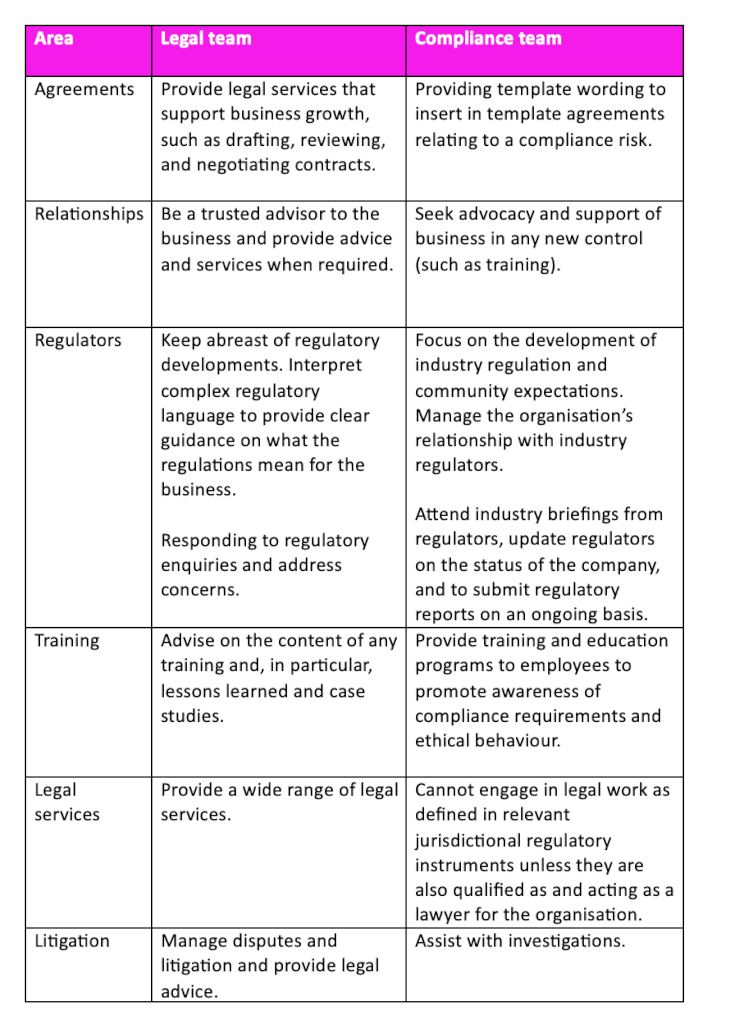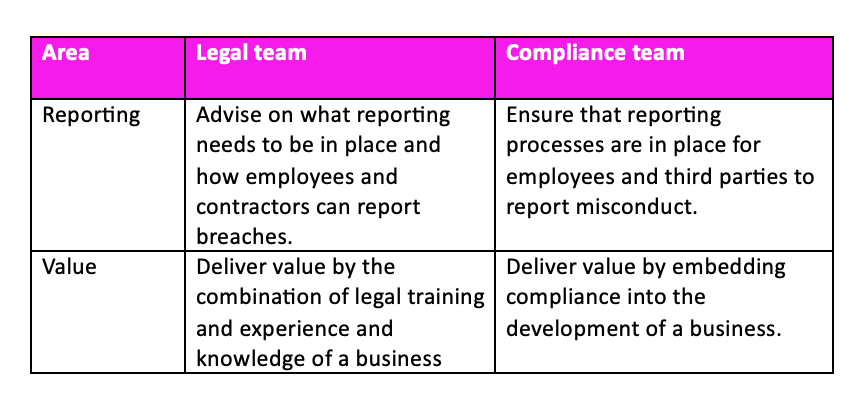What MacBook’s and PCs can teach us about the differences between in-house legal and compliance

Apple Advert: I’m a Mac and I’m a PC
Before we start:
In this articleI delineate the differences between legal and compliance and provide a table of comparisons. But before you read about that, find out about me.
About me: As a compliance professional, lawyer (qualified in the UK and Australia) and self-confessed ‘creative’, I will be sharing my observations and experience over the past 25 years working as an in-house legal counsel, head of risk and compliance, an external compliance consultant and trainer and Principal of my own law firm.
What I’ve done: Having worked with organisations including Aon, Airbus, Aristocrat, Deliveroo, LinkedIn, Microsoft, Oxfam, Rabobank, ResMed, Rio Tinto, Rolls Royce, The Uniting Church of Australia, Westpac, Wesfarmers and many more, I have seen the different strategies, structures and ways that legal and compliance teams operate.
I have also had the privilege of not just providing legal advice and risk and compliance services but also developing legal and compliance communication, training and marketing programs. I will be focusing on the importance of these three aspects as part of any successful legal or compliance program.
How I write: In each article I will be using the Untold Compliance Frame Training Method™ methodology of the Pre-frame and Post frame. I use this in all of my training and communications and talk about it in my complimentary course (details at the end of this article) and my upcoming book Told: How in-house legal and compliance professionals secure airtime, gain traction and transform organisations.
- The Preframe sets the stage and influences how people perceive and remember information, acting like a movie trailer to spark curiosity.
- The Post frame reinforces key takeaways and action items, aiding retention.
What I write about: Each week I provide a different insight. This week I am starting with the difference between an in-house lawyer and compliance professional. I am not going to merely focus on the obvious differences, such as lawyers draft and negotiate contracts, or that lawyers deal with litigation. Instead, I am going to focus on the areas where there is and could be some overlap.
What you will learn in this article:
- Differentiating Legal and Compliance Teams
- The Importance of Preparation
- Effective collaboration between legal and compliance teams
- Utilizing the Frame Training Method™
I’m a Mac and I’m a PC: The Preframe
Do you remember the advert “I’m a Mac and I’m PC.” There was a conservatively dressed man with who talked about what a traditional PC can do (to the left of the picture) and a more casually dressed man who talked about what cool things a Mac can do.
To be totally honest with you, I am a Mac user. Many of my clients and colleagues and friends are and always will be PC users. But that is not the point of this article. It is also definitely not to say that either department (legal or compliance) is cooler than the other.
But it does illustrate an important point – that their functionality is very are different and also will be. Just like PCs and Macs.
Whilst collaboration between these teams is essential to ensure the organisation is protected, it is also important to identify the differences.
What is the main difference when looking at legal and compliance teams when it comes to regulatory and compliance?
“I’m the Past and Present and I’m the Future.”
Firstly, I want to start by saying that when it comes to compliance, both teams play a crucial role in protecting the organisation. However, they do so in different ways.
Legal tend to focus on the past and present and Compliance on the future. Let’s examine.
The future proofers
Compliance is responsible for ensuring that the organisation can comply with applicable laws and regulations through an effective compliance program that mitigates risks and promotes ethical behaviour. If you are a compliance officer you will possess a deep understanding of the compliance landscape, can interpret complex regulations, provide guidance, and educate employees on compliance matters.
You will also be able to conduct risk assessments to identify any potential compliance gaps. You can proactively address areas of concern and develop strategies to mitigate risks. In addition, you can monitor changes in laws and regulations to future proof the organisation and ensure that it remains up to date and compliant.
The privileged advisers
A legal team, on the other hand, will focus on the past. You are focusing on what has happened. You are doing the deep dive, the investigation, the root case analysis and advising the organisation on exposure. You will be working with Compliance on what, if anything, requires disclosing to a regulator.
It is essential that you in the legal team is involved in any potential breach in order that any communications attract privilege, which protects certain communications from being disclosed in legal proceedings.
You will also focus on the present. You are the trusted legal counsel to senior management. You provide legal guidance and ensure that the company’s actions align with legal requirements. You are involved in all aspects of the business, from contract negotiations to litigation management. You are very much the present.
Table of responsibilities.
Below I have set out what each team is typically (in my experience) responsible for. Please comment if you want a word version of this table.



The Post-frame: Use this information practically
Key takeaway one: Ask “How can we best work together?”
One thing I always advise my clients is to share and agree the delineation of roles between legal and compliance with each of the teams. This is important for two reasons:
1. Surprises are not always good: they can cause conflict, uncertainty and wasted time. It can lead to unnecessary work in resolving or preventing an issue before we even begin the work we need to do. I have seen this on countless occasions in my various roles.
2. Brain speed: our brain has two systems, fast and slow, according to Daniel Kahneman. One system is fast, intuitive, and emotional; the other is slower, more deliberative, and more logical. If you are interested in learning more about this, I highly recommend Kahneman’s book: Thinking Fast and Slow. The basic premise is that our brains work much faster with information we already know. We work much slower when we have to think or learn something new. There are certainly time when we need to be slower and deliberative, but deciding who does what (in the middle of a crisis) is not that time. We want speed.
Key takeaway two: Prepare to work together
So based on the above, my strong guidance when working with organisations has always been to prepare each other before hand about each other’s roles. I suggest doing this in a positive, collaborative, practical way by identifying scenarios and putting some certainty in for each one. For example:
- What is our operating system going to be when we learn about a breach?
- What happens when we want to update a policy? Who does what?
- Who conducts a risk assessment? How does legal support compliance and vice versa?
- What happens in the case of an incident being reported?
- Who delivers compliance training? Who prepares the training?
Key takeaway three: Learn the art of the Preframe
When having sensitive or potentially complicated conversations with colleagues in other teams, it is always useful to learn how to proactively prepare the other party for the conversation and then follow up with a Postframe to ensure that they know what to do going forward.
Over to you
Attend my complimentary Frame Training Method workshop. It is on weekly each Tuesday or Wednesday (depending on where you live). Register below to get details of weekly sessions. CPD points will be awarded.
- Have a chat: https://calendly.com/nicoleroseuntoldcompliance/30-min-coffee-chat book in for a complimentary 30 minute chat to talk about anything that you want to improve in your legal or compliance program. I guarantee you will walk away with at least one great insight.

